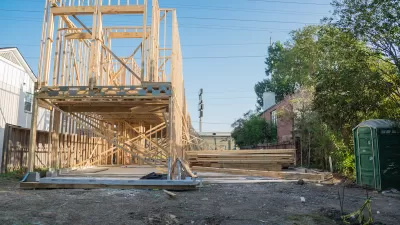Nolan Gray of George Mason University and Adam A. Millsap of the Charles Koch Institute write about a recent article they authored in the Journal of Planning Education and Research.

Infamous for its sprawl and lack of zoning, Houston hasn’t exactly been the average practitioner’s idea of a planning pioneer. But this skepticism is unwarranted. A great deal of planning progress in America's fourth-largest city has gone largely overlooked, from its trendsetting bus system redesign to its ambitious new bike plan. Things are changing in the Bayou City, in no small part due to a minimum lot size reform that occurred in 1998.
In a paper in the Journal of Planning Education and Research, we analyze Houston's 1998 minimum lot size reforms and find that they offer a highly instructive case study for planners across the country exploring ways to address mounting housing shortages.
Some background about Houston's unique system of land-use regulation is in order: The city lacks zoning, meaning it does not comprehensively segregate uses or control densities. However, this does not mean that land is unregulated in Houston. Many standard land-use regulations, such as front setbacks and minimum parking requirements, are in effect. Public regulation is in turn augmented by private deed restrictions that are enforced by the city.
One public regulation is minimum lot sizes, which set a floor below which lots—typically for detached single-family homes—cannot be subdivided. Previous research has found these restrictions often bind new development, forcing lot sizes to be larger than consumers might otherwise prefer. One result of this is higher housing costs. In 1998, Houston dropped the minimum lot size for single-family homes from 5,000 square feet to as low as 1,400 square feet within the city’s I-610 loop, a reduction of roughly 72 percent.
Our study addresses two big questions: First, how did such a transformative reform take place? Evidence indicates that a perfect storm of a rising population, rising incomes, and a renewed demand among young professionals created a market for new housing close to major job centers. Changing ideas among our profession also helped, as planners warmed up to the virtues of increasing urban densities and improving walkability.
Homeowner opposition, which is often well-positioned to undermine efforts to expand the housing supply, also had to be managed. Similar to how Houston owes its lack of zoning to the option to "opt out" with publicly enforced private deed restrictions, a similar "opt out" process ameliorated opposition to the 1998 minimum lot size reform. The reform included an option allowing blocks and areas to opt out of the new 1,400 square minimum and adopt their own local minimum lot size. Compromising with homeowners with the highest preference for the status quo likely cleared a path for citywide lot size liberalization.
Next, we examine how this reform impacted Houston’s neighborhoods. Did developers flock to the most affluent neighborhoods? Or did this shift subdivision activity to lower-income neighborhoods with lower land values? Using both GIS data and regression analysis, we find that the new 1,400 square foot lots were overwhelmingly developed in two types of areas: First, in neighborhoods where there was substantial underutilized former commercial and industrial land, and second, in largely underbuilt middle-income residential neighborhoods.
The scale of this change in much of western Houston is hard to overstate. Many neighborhoods, such as Shady Acres and Rice Military, have been completely transformed. In many cases, this has involved the subdivision of conventional post-war 5,000 square foot lots into three townhomes, effectively tripling population densities. We hypothesize that the wealthiest areas avoided subdivision activity through existing deed restrictions, while middle-income neighborhoods absorbed much of the demand, minimizing redevelopment pressure in low-income neighborhoods.
We draw two lessons for planning practice from this case study. First, allowing the most extreme opponents to “opt out” of land-use reform may help clear a path for citywide liberalization. While planners and policymakers should be prudent, such compromises may make sense where local politics otherwise blocks reform. In Houston, the compromise was deemed acceptable, and the result has been over 25,000 new housing units close to major job centers.
Second, citywide land-use liberalization is likely to direct growth into middle-income and underbuilt neighborhoods, barring other institutional constraints. While this comes with separate risks—such as disinvestment from lower-income areas—it may help to ease concerns regarding displacement.
There is no universal solution for any given planning challenge. While the Houston experience is instructive, it remains incumbent upon communities to judge the relevant costs and benefits of any growth strategy.
Nolan Gray is a professional city planner and a fellow with the Urbanity Project at the Mercatus Center at George Mason University.
Adam A. Millsap is a Senior Fellow at the Charles Koch Institute and a contributor to Forbes.

Alabama: Trump Terminates Settlements for Black Communities Harmed By Raw Sewage
Trump deemed the landmark civil rights agreement “illegal DEI and environmental justice policy.”

Study: Maui’s Plan to Convert Vacation Rentals to Long-Term Housing Could Cause Nearly $1 Billion Economic Loss
The plan would reduce visitor accommodation by 25% resulting in 1,900 jobs lost.

Planetizen Federal Action Tracker
A weekly monitor of how Trump’s orders and actions are impacting planners and planning in America.

Wind Energy on the Rise Despite Federal Policy Reversal
The Trump administration is revoking federal support for renewable energy, but demand for new projects continues unabated.

Passengers Flock to Caltrain After Electrification
The new electric trains are running faster and more reliably, leading to strong ridership growth on the Bay Area rail system.

Texas Churches Rally Behind ‘Yes in God’s Back Yard’ Legislation
Religious leaders want the state to reduce zoning regulations to streamline leasing church-owned land to housing developers.
Urban Design for Planners 1: Software Tools
This six-course series explores essential urban design concepts using open source software and equips planners with the tools they need to participate fully in the urban design process.
Planning for Universal Design
Learn the tools for implementing Universal Design in planning regulations.
Caltrans
Smith Gee Studio
Institute for Housing and Urban Development Studies (IHS)
City of Grandview
Harvard GSD Executive Education
Toledo-Lucas County Plan Commissions
Salt Lake City
NYU Wagner Graduate School of Public Service






























